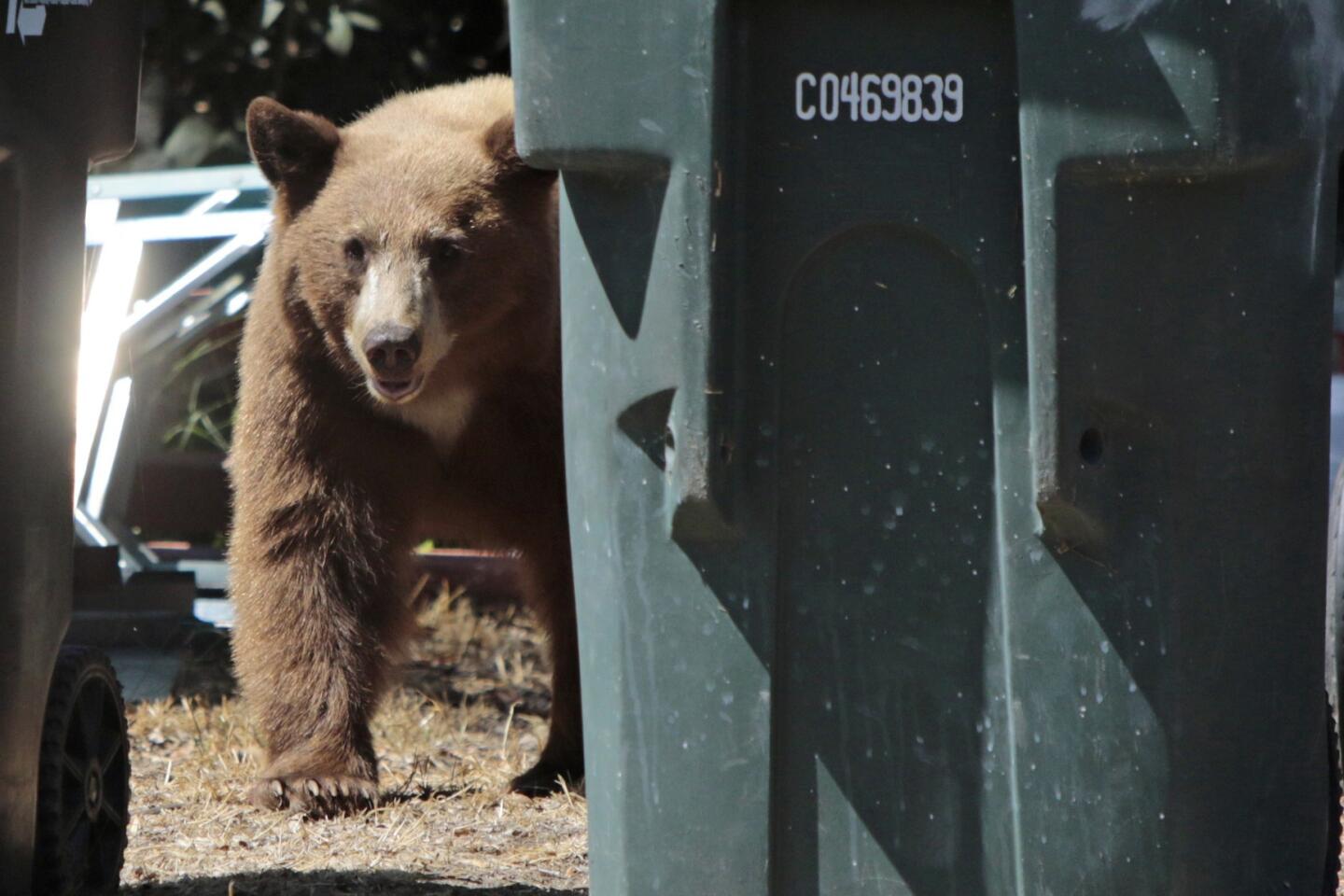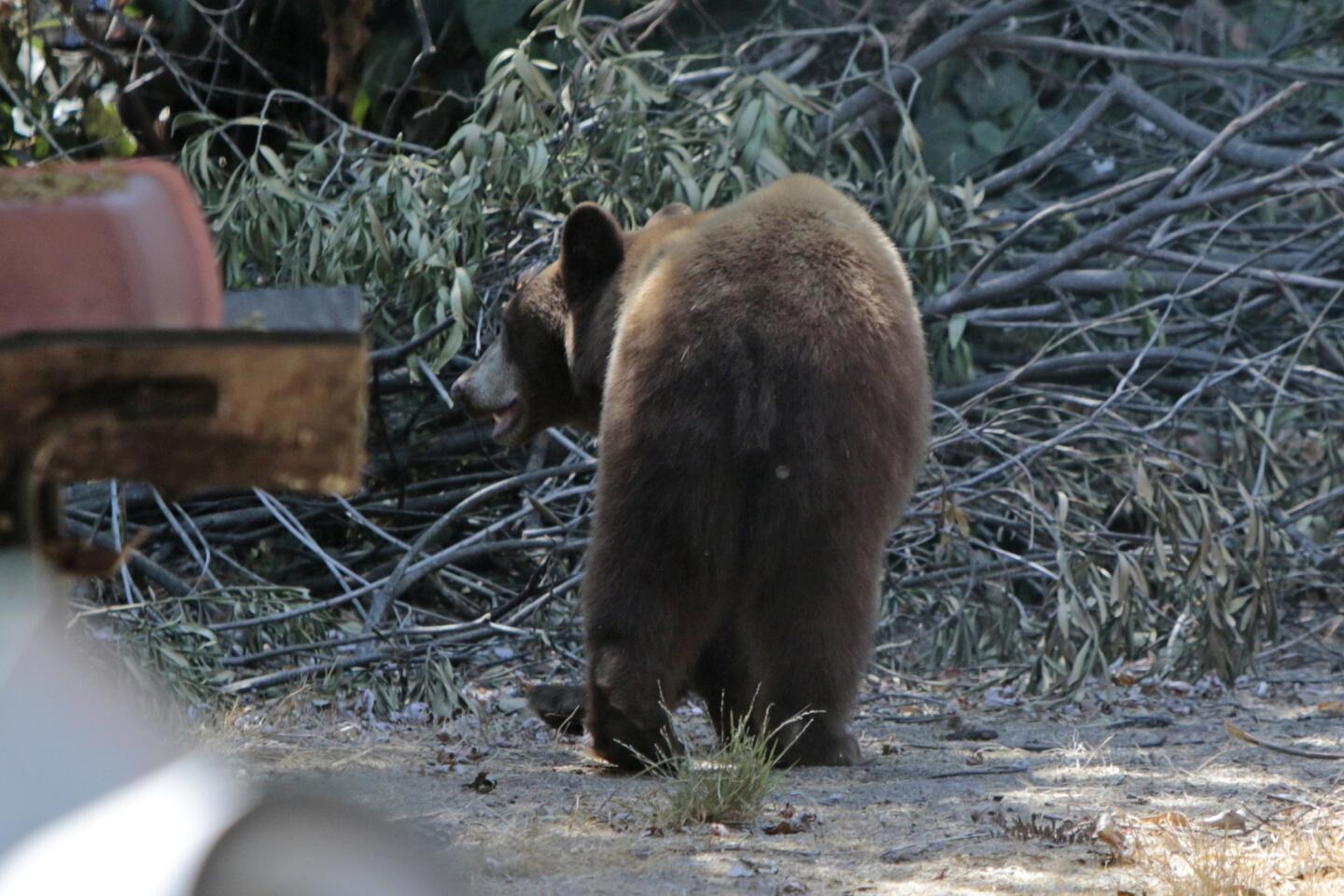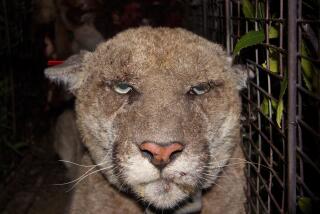Wildlife part of the territory of L.A. life
Why did the monocled cobra slink across the road? To give Los Angeles County animal control officers the slip, of course. It didn’t work; the nomadic ophidian is now in residence at the San Diego Zoo. And while the hooded snake sighting and ensuing four-day chase unnerved some Thousand Oaks residents last month, for Department of Fish and Wildlife Patrol Lt. Marty Wall, wild encounters in the concrete jungle simply go with the territory.
You might not think that the Los Angeles basin, with its rivers of traffic and concrete, would be a likely home to wildlife. But you’d be wrong. Wall has seen a lot of strange things roaming the big city in 22 years with the department, ranging from a baboon on a front porch in Chatsworth to a bear on a Northridge golf course. The Thousand Oaks serpent wasn’t the first cobra to slither across a Southland street, Wall said — although its Twitter following (@AlbinoMonoCobra, @Toakscobra) and the fact that it’s white, not albino, according to zoo officials, certainly makes it unique. And, oh, by the way, if you see a bear on a golf course, “get out of the way,” Wall said. Even if you think you’re channeling Tiger Woods, “let the bear play through,” he added.
L.A.’s wildlife comes from a variety of places. The escaped baboon was legal, permitted by Fish and Wildlife and returned safely to the owner. Bears and mountain lions follow flood-control channels and can get lost in the heart of the city. Deer are drawn to drought-resistant plants that are popular with developers. Mountain lions and coyotes follow deer and other smaller animals. And many critters (bats, foxes, mice, opossums, peacocks, raccoons and skunks) just live among us.
As home builders expand into undeveloped areas and water sources wane in the drought, human-wildlife encounters can seem more common. Still, while a tweeting cobra with a Facebook page can make it appear that the wild things are taking over, Wall said animal populations haven’t changed much.
“If I had to blame anything for the perception, I’d blame social media. Information gets out so quickly,” he said.
Wall, whose squad includes three other wardens and services L.A. County north of Interstate 10, said he resolves most of the department’s cases, one or two a month, by showing up, creating a safe escape route for the animal and asking police and residents to step back. No, really, take a big step back, Wall said. “The animal will go on its way. I’ve never seen a bear skeleton up in a tree. They always come down. You just have to let them,” he added.
Wall said bear, deer and mountain lions prompt the most calls. And not every story has a happy ending. Animals that can’t get home unaided and those that pose a threat to public safety are captured and relocated (often to the nearest forest or animal sanctuary) or killed.
Bears and mountain lions may steal the media spotlight, but L.A.-based trapper Johnathan Russell said coyotes, opossums, raccoons and skunks cause more trouble for homeowners.
In August, Janet Keyte realized that a ring-tailed house guest had moved into her La Crescenta home when the 10-week-old cubs started roughhousing at 5 a.m. Her son called five raccoon removal companies before he reached Russell’s.
The trapper arrived the next day. During the hourlong service call (average cost: $300 to $400), he surveyed the roofline opening, photographed the feral clan and left pads scented with male raccoon pheromones in the attic. Russell said the female raccoon, sensing danger, would likely move the family within three days.
Keyte, who had raccoons in the house once before, planned to seal the roofline and prepare for some ribbing from the locals, the human ones.
In Seal Beach, it’s coyotes that are prompting calls. Residents say they have become too brazen after killing dozens of pets, and the City Council recently approved a plan to start trapping and euthanizing them.
Even the experts get stumped at some encounters. Madeline Bernstein has been with the Society for the Prevention of Cruelty to Animals Los Angeles for 20 years. But when her husband called about the lion in the garden of their Encino home in 2009, she was befuddled.
“I said, ‘Do you mean a lion or a bobcat?’ He said, ‘What’s the difference?’ I said, ‘If it’s a lion, stay inside … make some noise,’ ” she recalled.
The animal left, but Bernstein never forgot the encounter. And she’s had a few more since.
“It’s interesting that you can have raccoons and bobcats and opossums and coyotes all showing up at your door in Los Angeles. I moved here from Manhattan,” she added, “but I still look around every once in a while and think, ‘This is a lot of wildlife for a city chick.’ ”
If you witness a wild animal attack, call 911. To report a coyote or mountain lion sighting, call the California Department of Fish and Wildlife Natural Resource Volunteer Program (www.dfg.ca.gov/volunteer/NRVP) at (858) 467-4201.
::
How to report animal issues
Got an animal problem?
To report a barking dog or a stray animal in the city of Los Angeles: laanimalservices.com or (888) 452-7381.
To report any injured wildlife to the L.A. County Department of Animal Care and Control: animalcare.lacounty.gov or (562) 940-6898.
To report animal cruelty: spcala.com or (800) 540-7722.
To report poachers at Cal-TIP: dfg.ca.gov/enforcement/caltip.aspx or (888) 334-2258.
To contact Fish and Wildlife law enforcement: dfg.ca.gov/enforcement or (916) 653-4094.
More to Read
Sign up for The Wild
We’ll help you find the best places to hike, bike and run, as well as the perfect silent spots for meditation and yoga.
You may occasionally receive promotional content from the Los Angeles Times.








